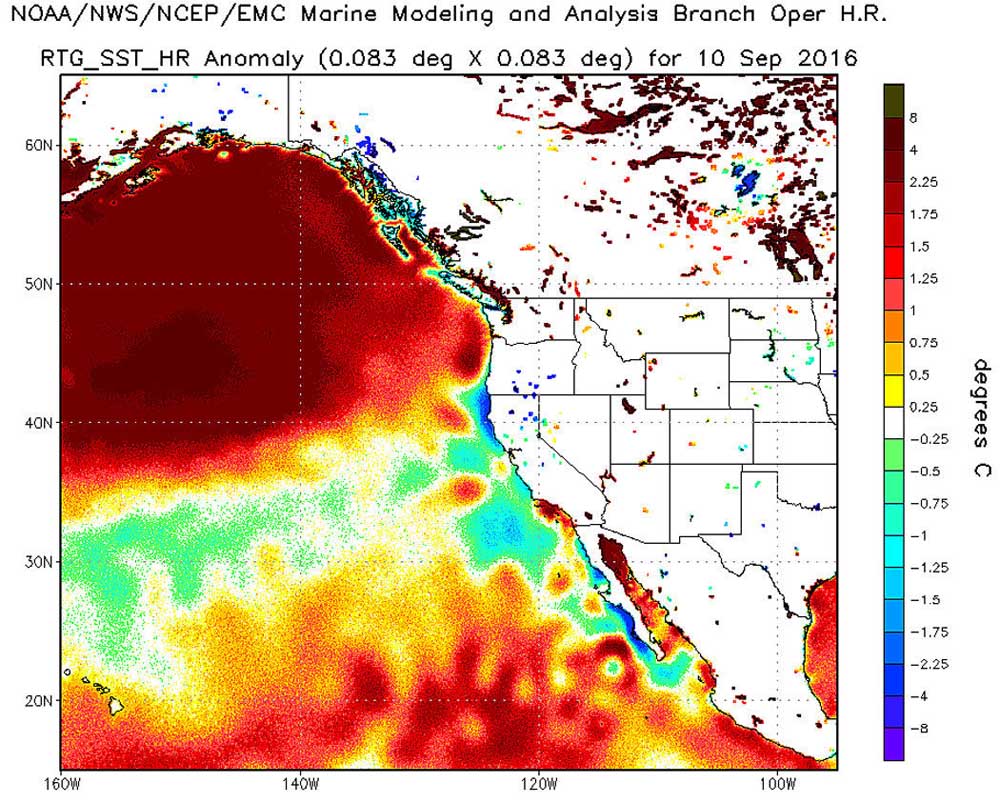‘Son of a Blob’ springs to life in Pacific
Published 8:00 pm Tuesday, September 13, 2016

- Satellite monitoring on Saturday found a huge area of warmer than normal surface temperatures in the northeast Pacific Ocean.
LONG BEACH, Wash. — The Blob, a news-making patch of unusually warm ocean surface water from late-2013 through autumn 2015, was reborn this month.
Trending
The ocean warmed quickly. As recently as July, “The northeast Pacific off our coast was slightly above normal, but nothing exceptional,” University of Washington meteorologist Cliff Mass noted Sunday in his popular blog.
By Saturday, some limited areas well off the coast were 5.4 to 7.2 degrees above normal, Mass said, while satellite monitoring shows an enormous zone of overall warmth extending west from the coasts of Washington state and Oregon, north to Alaska.
So far at least, this “Son of a Blob” isn’t shaping up to be as much of a bad boy as its old man.
Trending
Washington State Climatologist Nick Bond said Monday that, “Indeed the blob is getting kind of reinvigorated. … I doubt whether the magnitude of the anomalies will approach those that we observed during the last couple of years. It does stack the deck slightly for warmer weather during the next couple of seasons, but not to a great extent.”
Bond said he thinks our upcoming winter will not be “quite as toasty as the last two,” in part because an “upwelling favorable wind the past summer cooled off the water to normal or even slightly cooler than normal right near the coast.”
The Son of a Blob arrives just as climate experts have officially declared this will not be a La Niña winter. The flip side of more-famous El Niño conditions that influenced the warm winter of 2015-16, La Niña is a pattern of unusually cold surface waters in the equatorial Pacific Ocean. It tends to bring wetter and cooler winter conditions to the Pacific Northwest.
“Because La Niña is shaping up to be a weak sister, my hopes for a cold winter seem unlikely to be fulfilled,” Bond said.
On Sept. 22, the National Oceanic and Atmospheric Administration will issue its new 30- and 90-day long-range forecasts, and will try to determine how the Son of a Blob will influence our weather in a winter with neutral conditions — neither El Niño nor La Niña.
A result of a persistent zone of high atmospheric pressure in our part of the Pacific, the original Blob created “highly unusual weather,” Bond said at the 2016 Pacific County Marine Science Conference in Long Beach in May.
Ocean conditions made their way onto dry land in the form of drought and record temperatures — “2015 was by far the warmest year we’ve had in the Cascades” and “Oct. 1, 2014 through September 2015 (was a time of) record warmth in much of the Northwest.” Widespread forest fires and possibly the largest documented seabird mortality event in world history were linked to the 2013-15 Blob.
Mass said Sunday that experimental modeling he conducted found a modest 1 to 2 degrees increase in land temperatures from the original Blob. But even that amount of additional warmth can have a noticeable influence on snowpack and other terrestrial conditions in the Pacific Northwest.
In terms of its impacts, the new Son of a Blob “probably is more meaningful to the marine ecosystem, particularly if the models used for seasonal weather prediction are on the right track,” Bond said this week. “They are showing water being something like 1 to 1.5 C (1.8 to 2.7 degrees F) above normal in a wide band along the coast, as a group.”
At this spring’s science conference, Bond predicted the Blob would come back, but didn’t expect it to do so this soon. Asked about this Monday, Bond said, “Whether I am surprised or not is a good question. I have been surprised at how strong and persistent the temperature anomalies have been, in both the ocean and atmosphere, and so it takes a lot to startle me at this point.”









